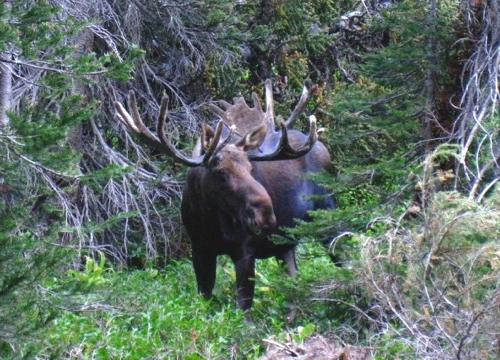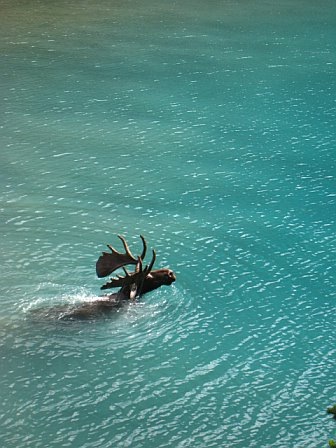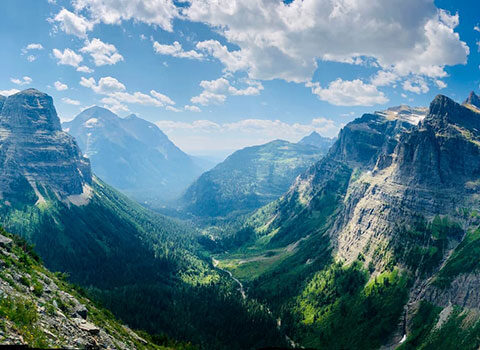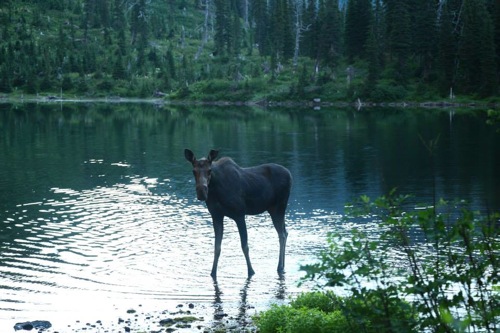Glacier National Park Critters: Moose
Moose are one of the most fascinating animals you might encounter in the backcountry of Glacier National Park. They are incredibly recognizable, but most folks don’t actually know a lot about them. You might learn more about them on a guided hiking trip with us, but for now . . .
19 Facts About Moose That You Probably Didn’t Know.

Moose are easily startled because they can’t see very far. This makes them uneasy because they can smell and hear that something is coming, but probably can’t see what it is. Photo by Glacier Guide Sarah Metzger.
Depending on the species, moose can weigh as much as 1600 lbs. The species found in Glacier is called the Shiras moose, and weighs between 600 and 800 lbs.
Twins are pretty common. If a female is healthy and well fed, her chances of having two calves instead of one are high.
Moose are incredibly near-sighted. Their eyes are great for spotting nutrient-rich vegetation on the bottom of ponds and shallow lakes while they graze, but they can’t see across long distances worth anything.
They can store 100 lbs of food in their stomachs. Yes, you read that right. 100 pounds.
Moose make all sorts of funny noises. Bulls make a loud bellow, and they also croak and make a barking noise during the rut. Cows make long quavering moans that end with a strange cough-like sound. They also grunt to communicate with their calves. Both sexes snort when agitated. (We’ve been on the receiving end of this snort. .. NOT a fun experience.)
Harsh, long, cold winters are great for moose because they are incredibly susceptible to winter ticks. Winter ticks can’t survive and reproduce if there is still snow on the ground when they release from animals they’ve been feeding on, so long, cold winters help keep tick populations in check and keep them healthy.

Moose love to swim, and will often dive all the way under and swim for extended periods of time to stay cool on hot days. Photo by Glacier Guide Sarah Metzger.
They are born knowing how to swim and continue to be great swimmers as adults. A full-grown moose can swim 6 mph, and keep that pace for two hours. “Why do moose swim,” you ask? It helps them keep their body temperature down on hot summer days.
Winter makes for tough grazing, so it’s not unusual for a moose to lose nearly 30% of their body mass during the winter months.
Males expend as much energy growing their antlers every year as the females expend during pregnancy.
They can close their nostrils, which gives them the ability to graze under water.
Their respiration rate also slows down when they are in water, which allows them to stay underwater for long periods of time.
Moose spend so much time in water that it prolongs their life. Seriously. Standing around in water all day takes some of the stress off their bones and joints (think water aerobics…lower impact than running, right?), which reduces their chances of osteoporosis and arthritis. Also, just being in a couple feet of water discourages predators like wolves and mountain lions from attacking them, because it’s a lot harder to sneak up on something that’s surrounded by water.
A charging moose can come at you at 35 mph!
Don’t look ’em in the eye. Males are territorial and irritable during the rut, and will take staring them in the eye, aggressive posture, and stomping your feet as a sign that you want to go a few rounds with him, so it’s best to avoid all three, unless you can run 36 miles per hour.
They can move each eye independently.
Bear spray (in spite of its very specific sounding name) could be used to deter a charging moose, but their respiration rate is so low that it could stay in their lungs and cause permanent, and potentially fatal damage. Because of this, it’s best to tread lightly around moose and avoid instances where they might charge.
A bull’s antlers can weigh 50-60 lbs. That’s a lot to lug around on their heads, and we bet it feels pretty funny when they shed the first one and have to walk around lopsided until the other side falls off.
One of the biggest threats they face comes from a snail. Certain snails carry a parasite called brain worm (Parelaphostrongylus tenuis), and these big critters frequently ingest small snails while foraging in warm, shallow water. Brain worms cause neurological damage that can be fatal to moose. Interestingly, all other members of the deer family often carry brain worms, but are unaffected by them.
Moose have no upper front teeth. This space allows them to suck small marine plants into their mouth while grazing underwater.

A bull moose, with antlers just starting to regrow, plunges into McDonald Creek early spring. Photo by Tim Rains, Glacier NPS.
Do you have a favorite moose story to share? Tell us about it in the comment section! And be sure to join us for a guided hike in Glacier while you’re here.
Questions about Moose in Glacier National Park? Hit us up, we love being your guides in real life and virtually!
**most of these facts can be found on the following sites:
https://www.maine.gov/ifw/wildlife/species/mammals/moose.html
https://www.nps.gov/romo/learn/nature/moose.htm,
https://www.isleroyalewolf.org/overview/overview/moose.html
https://cutemoose.net/moose_facts.htm


